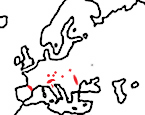|
Alpine Marmot
(Marmota marmota) |
||||
|
|
Physical
characteristics and distribution
|
|
The Alpine Marmot has a thick body with short legs and dense fur. The fur is short, smooth and yellowish brown on the body. Fur around on the head and nape is gray and the nose is white. The tail is short and hairy, ending in a black tuft. Body length is 50-60 cm and the tail length is 13-16 cm. It
generally lives in open areas such as meadows or forest edge.
Marmots spend most of their lives in deep burrows, hibernating
up to nine months of the year. The diet consists mainly of
green vegetation like grasses but may also include fruits,
grains and insects. Marmota marmota occurs in the Swiss, Italian, and French Alps; W Austria; S Germany; Carpathian (Romania) and the Tatra Mtns (Czech Republic, Poland); intorduced into the French Pyrenees, E Austria nd N Serbia and Montenegro. |
|
Description
of the brain
|
|
Animal
source and preparation
|
|
All
specimens collected followed the same preparation
and histological procedure.
|
Other Related Resources (websites and publications)
List of Specimens | Explore Collections | Brain Sections | Brain Evolution | Brain Development | Brain Circuitry | Brain Functions | Location and Use | Related Web Sites | Contact Us | Search MSU Database | Personnel | Home



